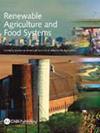美国有机乳制品三十年:农场、市场和有机法规的影响
IF 2
3区 农林科学
Q2 AGRICULTURE, MULTIDISCIPLINARY
引用次数: 0
摘要
摘要美国的有机牛奶食品体系有几个有趣的特点。该产品受到消费者的热烈欢迎,有机牛奶的零售额也随之增加。加工行业是寡头垄断行业,有三家占主导地位的公司。在农场一级,与牧场准入和牲畜过渡有关的法规的定义和执行一直是争议的主题,而且为了满足该部门的需求,变化缓慢。本文使用了美国农业部(USDA)的两个数据来源(农业资源管理调查和有机调查)和其他证据,追踪了关于有机乳制品、市场、加工和农业部门的讨论的变化,以及监管的演变。在整个30年期间,对农场一级法规的语言和执行不一致的担忧仍在继续。我们发现,在美国所有地区,有机乳制品行业在农场层面都有强劲且持续的增长。随着户外规则的收紧,每头牛可获得的牧场数量也在增加。2016年,许多奶牛场未能达到30%的放牧饲料门槛。另一个可能成为内部争论基础的关键发现是,2016年西方大型有机奶场的盈利能力大幅提高。其他地区的有机奶牛场没有出现这种改善,尽管它们的盈利能力与前几年相似。虽然有证据表明监管存在问题,但我们注意到,加工行业的结构是一个重要但被忽视的方面。因此,需要对农民与加工商的关系进行更多的研究,以提高我们对有机奶牛场部门动态的理解。本文章由计算机程序翻译,如有差异,请以英文原文为准。
Thirty years of organic dairy in the United States: the influences of farms, the market and the organic regulation
Abstract The US organic milk food system has several interesting characteristics. The product has been enthusiastically embraced by consumers, resulting in increased retail sales of organic milk. The processing sector is oligopolistic, with three dominant firms. At the farm level, the definition and enforcement of regulations relating to access to pasture and transitioning livestock have been the subject of controversy and slow to change to meet the needs of the sector. This paper uses two sources of the United States Department of Agriculture (USDA) data (Agricultural Resource Management Survey and Organic Survey) and other evidence to trace changes in the discourse about organic dairy, the market, processing and farm sector, along with the evolution of the regulation. Concern over inconsistencies in the language and enforcement of the regulation at the farm level continued throughout the 30-year period. We find evidence of strong and continued growth of the organic dairy sector at the farm level, among all regions of the US. The amount of pasture available per cow increased as the access to outdoor rules tightened. In 2016 many dairies failed to meet the 30% threshold for feed from grazing. Another key finding, which may underlie the internal debates, is that the profitability of large-scale organic dairies in the West substantially increased in 2016. The organic dairies in other regions did not experience this improvement, although their profitability remained similar to prior years. While there is evidence of problems with the regulation, we note that the structure of the processing sector is an important but overlooked dimension. Thus, additional research into the farmer–processor relationship is needed to improve our understanding of the dynamics of the organic dairy farm sector.
求助全文
通过发布文献求助,成功后即可免费获取论文全文。
去求助
来源期刊

Renewable Agriculture and Food Systems
农林科学-农业综合
CiteScore
5.20
自引率
7.40%
发文量
39
审稿时长
>36 weeks
期刊介绍:
Renewable Agriculture and Food Systems (formerly American Journal of Alternative Agriculture) is a multi-disciplinary journal which focuses on the science that underpins economically, environmentally, and socially sustainable approaches to agriculture and food production. The journal publishes original research and review articles on the economic, ecological, and environmental impacts of agriculture; the effective use of renewable resources and biodiversity in agro-ecosystems; and the technological and sociological implications of sustainable food systems. It also contains a discussion forum, which presents lively discussions on new and provocative topics.
 求助内容:
求助内容: 应助结果提醒方式:
应助结果提醒方式:


